Images and Textes Representing Successful Integration of Immigrants in Nordhorn:
NINO [text by Bibiana, Louisa M., Patricia]:
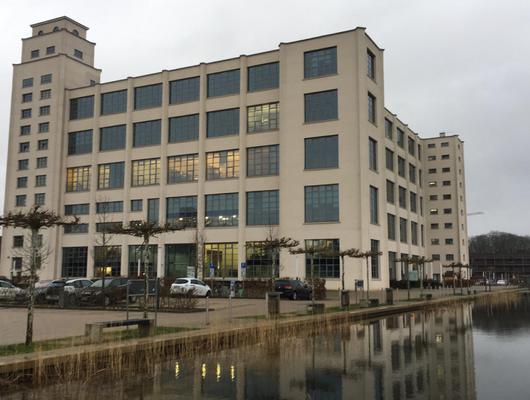
In 1897 Bernard Niehues and Friedrich Dütting founded the textile company Niehues&Dütting (N&D) in Nordhorn. The company grew strongly in the first few years and finally included a weaving mill, a spinning mill, a dyeing mill, a bleaching mill and its own power plant. The majority of the production facilities and administration were located in the immediate vicinity of the centre. During the 1920s, N&D achieved a leading position in the German textile industry and had about 3000 employees. The factories were also spared the Second World War. From 1950, the company sold their fabrics under the brand “NINO“ (Nihues/Nordhorn). In 1955 the company reached their highest employment level with 6100 employees. In the following years, NINO also experienced great success, with an increase in fabric production and sales. The reason for this increase in the number of employees is the recruitment agreement that Germany initially signed with Italy in 1955 and right after with countries such as Turkey, Portugal and Spain. From 1955, many guest workers came to Nordhorn and most of them worked in the textile industry. The guest workers worked as spinners, weavers, winders or combers in different shifts at NINO. Many of them lived in NINO dormitories or workers' housing together with other textile workers. In the 1980s the global competition in the textile market grew and NINO lost many employees. In 1994, NINO finally bankrupt but many company buildings are still used for other purposes.
NINO is a symbol of integration and migration in Nordhorn, as a large number of guest workers came here through the textile industry and the recruitment agreement. If the textile industries NINO, Rawe and Povel had not been in existence, only a few migrant workers would have come to Nordhorn because the labour market would have been too small. The guest workers who came since 1955 had better economic opportunities in Nordhorn as in their native country. NINO also provided them with housing and tried to accommodate their employees. The working life at NINO was another major factor influencing integration. Migrants and locals came together at work and had to work and communicate with each other. They also came together during lunch breaks and ate with each other. Through the local colleagues, the guest workers got to know the German culture and learned the German language. Despite initial communication difficulties, some friendships have developed beyond work, which stands for successful integration. Moreover, the textile industries like NINO are one of the reasons why the guest workers are still living in Nordhorn. Their new jobs and places of residence have created other symbols of migration such as the Portuguese Centre or the mosque in Nordhorn. The migrants wanted to maintain their culture and brought it closer to the Germans (or people who are living in Nordhorn). Trough this NINO (and the other textile industries) is a big factor of migration and integration and the creation of other integrational symbols.
The Portugese center [text by Louisa S.]:
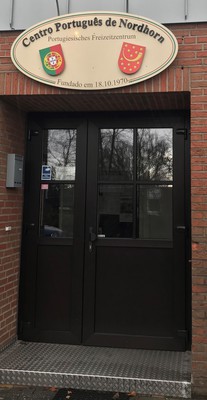
The Portuguese center in Nordhorn has a very long history. The club is established on the 18th October 1970 and was dedicated two years later in the 17th November 1972. The reason why this club was built were the foreign workers, which came in the middle of the sixtys to Nordhorn. They came, like many other people from ther countries, to work in the textile industry in the companies NINO or RAWE.
The start, when the first foreign wokers came from Portugal was very difficult for them. They had to face many problems because of the new language, the lack of apartments and their family situation, because they were mostly seperated. Due to of all these problems, the portugese center was such an important place. It was a chance for them to have a little bit of home country in Nordhorn and to escape from the everyday life and all of their problems. It was and also is a place where they can read, make music and of course talk to anyone who visits the club.
The club is characterized by its openness and diversity because everybody is welcome, not only Portuguese.
I would say the portugese center shows a good integration in two parts.
First it was a very big help for the portugese who came in the sixtys to integrate and at the same time to have a bit of their home counrty in Germany, which gave them the power they needed to that time. Nowadays it is also a good example for integration because everybody is welcome in this club and it is a place where different cultures can meet and learn about each other.
Diversity and openness are the most important elements when we talk about a good integration and because of that, I took this club as my example for integration in Nordhorn. In my opinion this center is the best example for good integration then and now.
Nossa senhora de Fatima - religios symbol of migration [text by Insa and Lars]:
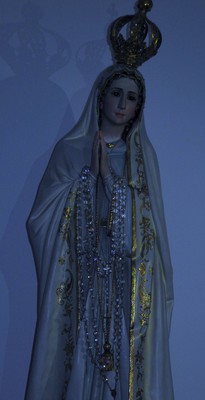
For many Portuguese the church was essential. Going to church, they could feel at home. St. Elizabeth's Church was a center of faith for many of the Roman Catholic Portuguese and Father Cornelius was their own priest. Later the masses were even held in Portuguese.
The textile company "Nino" realized how important the religion was to their employees and paid them a bus to get to church (“We lived nearby and were able to walk to the church. The people who lived far away got to the church by bus paid by Nino "). In the 80s the Portuguese got their own priests who came from Portugal to Nordhorn and organized their own Portuguese worship.
Today, the wooden Madonna, still standing in the church, is reminiscent of this Portuguese Catholic service. This Madonna, or as the Portuguese called her, "Nossa Senhora de Fatima" is a symbol of the Roman Catholic faith and was brought from Portugal to Nordhorn, with the help of Father Cornelius. For many Portuguese, the Madonna became a connection to Portugal. The procession in honor of the Blessed Virgen Mary which always takes place at the end of May could now be practiced with the Portuguese Madonna of Nordhorn.
We have selected the image of "Nossa Senhora de Fatima". because she shows us not only a geographical but rather a religious migration. It becomes apparent that it was important for the former guest workers to be able to practice their religious traditions far away from Portugal. For many of the Portuguese, the Madonna was not only a religious symbol but also a reference to her homeland and her religious traditions.
It was a pleasure for many guest workers and their families to go to church. During the dominical meetings, the Portuguese were able to speak their mother tongue ("that was a place where we really met."). Later a football club and a folklore group were founded near the church. Many Portuguese connected the church with free time and Sunday became a day to meet friends, a chance to speak Portuguese and to live out their culture ("After the church at 11 o'clock in the morning, it was football time. (...) that was a bit of our culture").
Although the Portuguese community hasn’t got their own priest since 1992 the Madonna still reminds us of the Portuguese guest workers and their migration that took place at that time.
Academico Portugues - a football club of Nordhorn with a Portuguese name [text by Insa and Lars]:
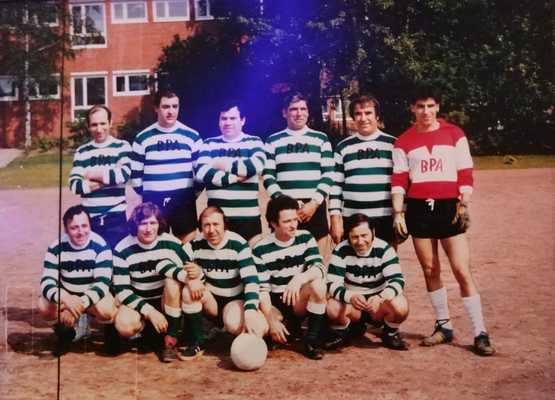
At first glance, the shirt of this local football club looks very ordinary. At second glance, however, one recognizes the far-reaching history of migration, which stands behind the shirt of the football club "Academico Portugues".
As you can see in the Portuguese name, this football club of Nordhorn was in former times a club with only Portuguese members.
This football club was founded in 1972 giving the many Portuguese guest workers a leisure opportunity in addition to work. Beside the catholic church “Elisabethkirche” and the Portuguese center, the football club was another place where many Portuguese people could feel at home.
The football club was well received and brought much Portuguese joy ("We men also had a football club (...) after the church we went there, almost all the men and the children (...) during two or three hours with the church and football we Portuguese were all together"). From
this quote of a guest worker’s child, you can also see how beneficial and invigorating such a football club must have been for the community among the Portuguese.
However, after its founding in 1972, a lot has changed. At that time the club consisted only of male Portuguese members, while today there is also a women's team since 2011. This female team won the indoor circuit championship. Also, the club is composed of different nationalities and all players play together for the victory nowadays.
Even the racist hostility during away games has diminished today, but this is raising out the question whether this is due to the change in society or because the football club "Academico Portugues" doesn’t longer consist only of people with a Portuguese background.
Therefore the shirt of the club is an important symbol for the migration. It shows another facet about the life of the Portuguese guest workers, there was more than only their daily work in the big textile companies. It shows that their lives consisted of more and that they have built up personal life. And perhaps with the football club, they have found a place where they could feel at home.
However, the fact that in the club now many people with different nationalities play together, the shirt of the club is also a symbol of integration. While previously people have played in separate clubs, they now play together. And the victory of the women's team proves the success of their decision to open the club for other nationalities and gender.
Kolpinghaus [text by Theresa]:
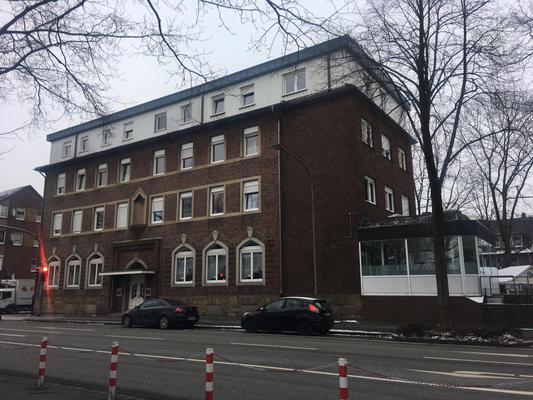
Today, the Kolpinghaus in Nordhorn is a home for men who have struggles with the use of alcohol and drugs. With getting an own room for themselves, the mostly homeless men are happy to have a place to rest. Looking back into the past, the Kolpinghaus wasn´t always like I described it above. Back in the 1960s the first guest workers from Greek, Spain and Italy arrived to work at the very famous textile factories in Nordhorn: Nino, Rawe and Povel. Coming here to earn more money than in their home countries, a lot of men searched for a place to stay. The Kolpinghaus was one of the first homes where they could live for only a little bit of money. The situation wasn´t always easy, most times the men had to share their rooms with two or even three mostly foreign guest workers, but for a lot of them it was bearable because they only came there to sleep after the hard work. After a while, also many Turkish workers came to Nordhorn and lived with all the other guest workers together. Even if there might have been some fights between the different groups, they mostly lived together very peacefully. Asking myself why the Kolpinghaus is a fitting image to show migration, I discovered many different reasons. First, the Kolpinghaus brought together a lot of different cultures, religions and origins. Not only the occupants learnt to accept different views, but also the German population. By accepting each other the guest workers often found a lot of new friends, no matter if they were German, Turkish or Italian. But not only the guest workers took something good out of this new situation, but also the Germans. Getting to know a lot of new people, the German population started to get more open towards new cultures, for example foreign food they never tried before but that are now very popular in Nordhorn (Ala Turka, La Gondola, Portofino). The second reason is that the Kolpinghaus gave many men the change to find a real home here. The location of the Kolpinghaus was also a positive factor for the migration of many people. While laying directly at the Stadtring and very near to the Postdamm, the workers lived in the central part of Nordhorn where they quickly experienced how the German everyday life was. Without the Kolpinghaus a lot less people could have stayed here in Nordhorn to build up a new life for themselves. After a while, the workers had enough money to rent an own apart and to let the family join them there. This wouldn´t have been possible if the Kolpinghaus didn’t gave them the chance to live here in the first months or years when they hadn´t enough money to rent a “real” apartment but searched for a temporary solution.
Sultan Achmed Mosque [text by Cigdem and Eda]:

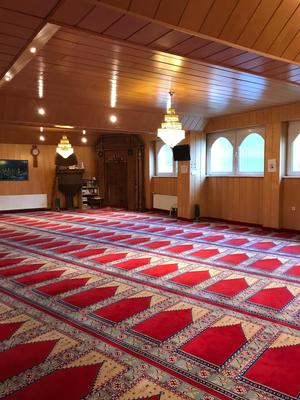
The mosque is a ritual place of communal Islamic prayer and a social meeting place. Since 1993 is in Nordhorn also the Sultan Ahmet Mosque in Augustastreet 12, which was founded out of the idea to help people in need. The mosque has a minaret, which doesn`t call to prayer as one knows it from Muslim countries, but it gives the mosque an external character. The daily prayers may in principle carried out everywhere, but if they´re carried out in the mosque it is considered particularly meritorious, because in this way belonging to the Muslim community is expressed. Only the Friday prayer is definitely bound to the mosque, because without the execution in the mosque, the Friday prayer loses its validity. Therefore Friday in the Sultan Ahmet mosque is the most visited day of the week. On Fridays there are therefore often kebab sales and the income of that also belongs to the financing of the mosque. To the financings belong likewise the donation proceeds or the sales of oriental specialities at special German celebrations, like e.g. the “Octoberfest”, “Hafenfest” (port festival) or at cultural Festival. These sales are made by volunteer helpers who are members of the mosque.
These sales are an example of our decision to take the Sultan Ahmet Mosque as a symbol of Integration and Migration in Nordhorn, because in a certain way the Muslims take part in the German festival and there is a mutual integration, since the Muslims get to know the German culture (maybe other cultures) and Germans the Muslim or oriental cultures.
The Sultan Ahmet mosque belongs to the Turkish-Islamic cultural association DITIB. The Imams of the DITIB association are sent by the Turkish state to Germany to look after the Muslim community. The Imam not only leads the prayer, he also teaches the children and young people to read the Koran, the various prayers and the teachings of Islam on weekends and holidays. The students learn a lot through games, handicrafts and competitions. The mosque attaches great importance to youth work and would like to expand it in the future, for example by offering German courses (to help refugees for example).
In the mosque there is a men´s as well a women´s area, each of which has a wash-room for the performance of the prayer washing. The mosque has also a local area with a kitchen and a dining area. Especially at Ramadan this is used to break fasting together (which is called Iftar). The local area has also an terrace, which is also used on warmer summer days. Specially at Ramadan Muslims enjoy when they get German visitors and eat together to Iftar and then drink tea together.
Often have the people there conversations in the mosque in which they talk about social problems and then try to find solutions together. Therefore we would say that the mosque is a symbol for migration, because it serves as a refuge for Muslims in a new environment where they can talk and learn German.
Turkish community - „Türk Dernegi“ [text by Cigdem and Eda]:
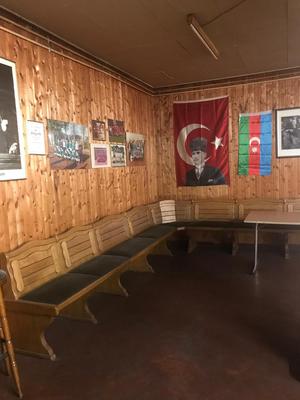
In recent decades, Turkish citizens have created a large number of organisations and associations in Germany within their ethnic-cultural communication circles. Most of them are cultural centres, mosque associations or functional associations such as parents- or entrepreneurs assocciations.
The Turkish community was founded in the centre of Nordhorn, in the Bogenstreet. 12.
The reason for the foundation was to creat a meeting place or refuge for Turks. It is only a meeting for men, who set together and also talked about problems. They helped each other and were an open ear for their fellow countrymen.
Many Turks, who did not speak German at that time, went there to improve their German language skills with the help of their fellow countrymen. So a lot of German was spoken in order to integrate better and this was a great support for most of them. They felt comfortable there because they were surrounded by people who also had the same difficulties or at least had the same difficulties.
Games were also played among each other, such as card or board games.
This community has been preserved until today and the Turkish citizens would like to take care of it for the next generations. They still see the community as a place of retreat and visit it regularly during the week. They usually drink tea or coffee and play games together.
The financing of this community takes place mainly through the donations of the own compatriots. They also rented their rooms for Turkish events such as bachelor parties.
Therefore we would say that the Turkish association is a symbol for migration or integration in Nordhorn, because it is till today a meeting place for the compatriots, where the feel comfortable and connect something with their homeland. They also help each other to learn German in order to integrate better in Germany.
Football club Weisse Elf Nordhorn [text by Laura]:
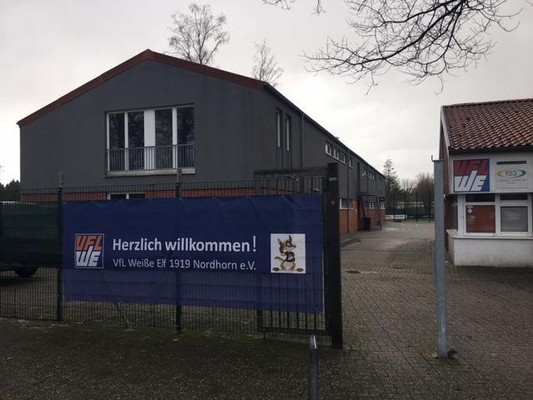
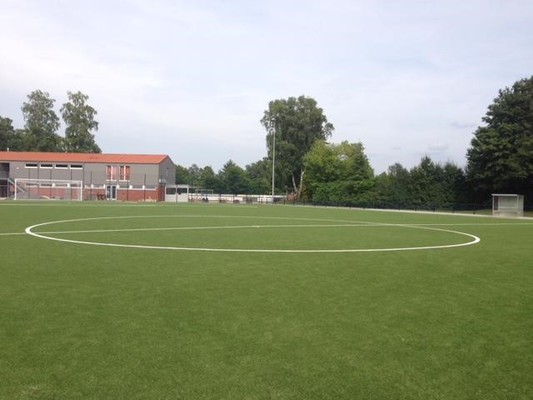
The club ’’ Verein für Leibesübngen Weiße Elf 1919 e.V. Nordhorn ’’, short ’’VfL Weiße Elf Nordhorn ’’, is a sports club in Nordhorn with direct proximity to the Dutch border. The association with its present name was founded in 1974 by the merger of the clubs
’’ Verein für Leibesübungen 1919 e.V. ’’ and ’’ Weiße Elf ’’.
Already in 1918 with the formation of the sports club ’’ Teutonia ’’ the beginnings for this club were laid, which was finally created by the emergence of new associations, mergers of different associations and new foundations. The club ’’ Verein für Leibesübungen 1919 e.V. ’’, which was founded in 1933, was dissolved in 1945 due to the military government, but resumed gaming operation after the end of the war.
In 1952 the club ’’ Weiße Elf ’’ was founded, which was a pure soccer club. To this day, the merger of these two associations is already continuing.
Besides the biggest department of the club, namely soccer, basketball, acrobatics, tennis, boules and other sports are offered as well.
For me, the club ’’ VfL Weiße Nordhorn ’’, especially in the soccer department, is a symbol for migration and integration. The first reason for this is that soccer brings people together, regardless of nationality.
The common goal is to achieve victory and this can only be achieved as a team. With regard to ’’ VfL ’’, it can be seen that there are many children as well as adolescent and adult members in the association who have a migration background. This is already noticeable when you look at the pictures and names of the teams on the website of the association. Here you can discover many names, which come above all from the Turkish and Portuguese.
It advertises that they are as welcome and integrated as everyone else and I think this is true in reality. This can be perceived, for example, when you enter the club grounds because then you can see many different cultures, which meet here and spend time together.
In addition there are team trips, for example to the Netherlands or Turkey.
The association is also part of the project ’’ Jugend für Europa ’’, which promotes an international youth movement, especially in Easten European countries.
The goal of the association is to let integration become lived normality and in my opinion it can be seen there.
I believe that everybody has the opportunity to find a kind of second home at the club ’’ VfL Weiße Elf Nordhorn ’’, reardless of their culture and nationality.
Finally I would like to say that, of course, there may be also exceptions and individual cases in this example where migration and integration do not work as intended, but I perceive this association as tolerant and cosmopolitan and find that you feel welcome and comfotable there, which is why it is a symbol for migration and integration for me.
Kara market import – export [text by Louisa M., Bibiana, Patricia]:
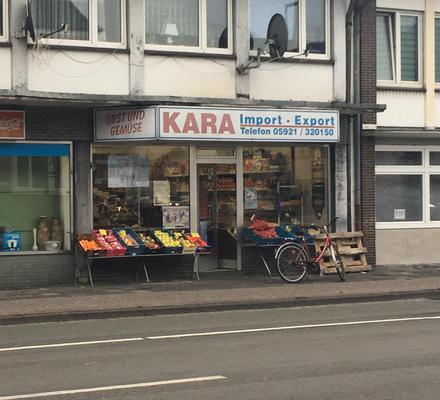
Since the 1980s, many traditional corner shops, called Tante-Emma-Läden, in Germany have been replaced by food shops run by immigrants. Today, many migrants from Turkey, Portugal, Italy, etc. own small shops that are reminiscent of the old corner shops. Particularly in recent years, these tradesmen have taken on an important role. In some villages they ensure local supplies.
One of them is Sabri Kara from Armenia. He is the owner of the Kara market in Nordhorn. It is located at Neuenhauserstraße 68 (street and house number) which is in the center of Nordhorn. For more than twenty years he offers Russian, Polish, Turkish and Asian food. For example: Russian sweets, Polish bakery products, Turkish spices and Asian specialties. Besides that he sells fish and halal meat. By that he considers Muslims. Sabri Kara imports food from different countries (especially fruits from middle East). Thereby immigrants do not have to live without their indigenous groceries. In Sabri Karas market different nationalities meet and become acquainted with other cultures. Even local people shop in the Kara market and learn something about foreigners and their habits. It is very important that both (local people and foreigners) get to know each other better. That leads to a deeper understanding of different nationalities and cultures (food specialities other mentalities and haviors). Many people have short but personal conversations.
Sabri Kara and many other self-embloyed migrants integrated into the labour market and society. They established an ethnic business. A very important aspect is that the food offer will be bigger. Earlier there were not many foreign companies in Germany and by that there were only a small selection of groceries from foreign countries. All and all the Kara market is a symbol of migration and integration, because people with different nationalities come together and discover more about other ways of life and other cultures. As well they learn to come out with others and accept their behaviors. Another point is that strangers with the same nationality have conversations and can help each other in everyday life. Through that especially older migrants can integrate easier into the German society. Integration is harder for the old people as for young people because they can integrate trough their everyday life like school or sport clubs. All in all the Kara market is a good example for integration and migration because food connects people even if they have different ethnic backgrounds.
Sirhan Shops – a delicious symbol of migration [text by Mzgin and Yasmin]:
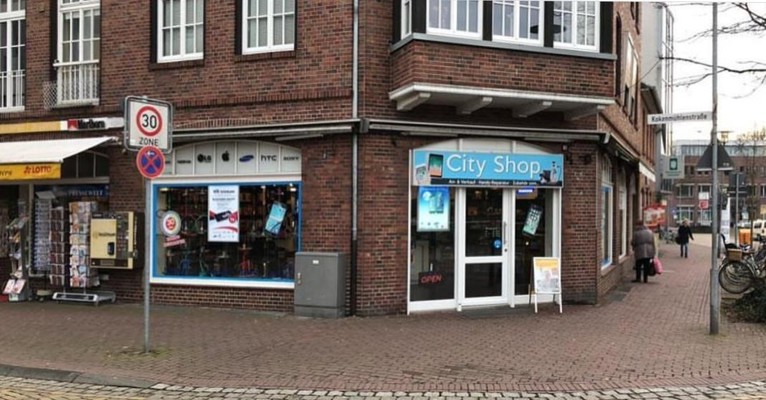
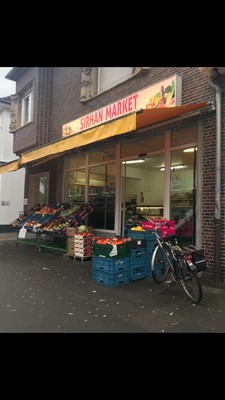
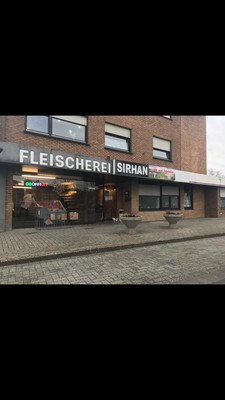
A symbol of successful integration in Germany are the shops of the “Serhan” family. They run three shops in Nordhorn, spread all over the city. Apart from the well-known vegetable market, they repair electronic devices in the city centre and run a butcher´s shop on the part of town “Stadtring”.
The cross-generational company has been in existence for over 30 years and was opened at that time to give the oriental guest workers the opportunity to follow their eating habits. Today one might think that only Turkish or Arab people buy still in their shops, but it is quite different. Surprisingly, German people buy there, too. The fact that not only people with an Oriental background buy from the “Serhan Shops”, but also other ethnic groups is a good sign of that they have been accepted into the society quite successfully. Differently than expected they sell not only Oriental food, but also German food to welcome also the Germans in their market. We talked with the shop owner and he told us that when he has first opened his stores there were mostly customers with Turkish or Arab backgrounds, but when he started selling German food as well, it changed. The interest of many citizens was aroused. Since the demand for Oriental specialties has increased massively in the last years, the owners expanded to Meppen and opened a shop there, too.
In integration, the will of the migrant to integrate into the new culture is as high as the retention of his cultural identity. Exactly this behaviour is reflected in the “Serhans” sales strategy: they show interest in the eating habits of new cultures while at the same time maintaining their own.
The market brings for example different cultures together and lets people get to know to other cultures or furthermore to their eating habits. Fortunately, the shops in Nordhorn never faced racism, which is often a normality in other bigger cities. With mixing of different cultural eating habits you can catch the interest of people with different origins and that made the family to an advantage and integrated and migrated in Nordhorn flawlessly.
The serving of meals for refugees [text by Carolin]:
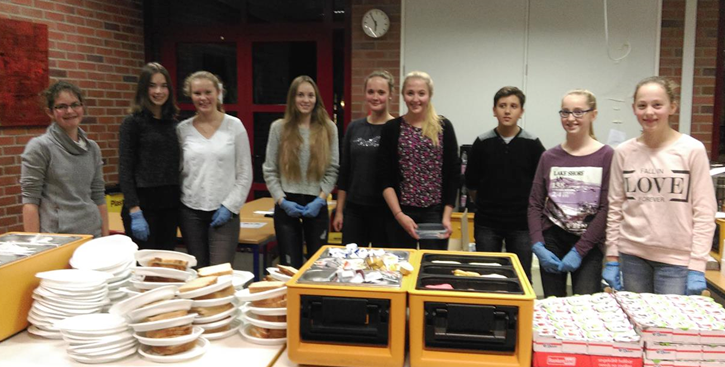
First I want to define the word “integration“ to give a short overview of how it can be connected with the serving of meals for refugees. The word integration is not exactly definable but striving for a life where you are accepted within society is the main objective of integration. To have equal rights is another decisive aspect. It is also important to show initiative of one´s own concerning of languages knowledge and legislation. All in all you can say that society and the respective person have to take action to achieve a successful integration. To bring this in connection with the serving of meals for refugees I would like to present the work there.
First of all I have to say that the persons who took part in the help for refugees were mostly voluntary helpers. The refugees from Syria and Afghanistan, for example, lived in a gymnasium together next to the cafeteria where the helpers gave them their food. There the refugees had to wait in line until the security allow them to enter. The cafeteria was divided into different stations for each kind of food. That means that they only got bread by the “bread station“ and so on. It had been the task of the helpers to make sure every refugee only got what he or she really needed (for example: one piece of cheese for one bread). There was a separate place with tables and chairs to eat.
The refugees were very thankful for our help and the food. Most of them were open-minded and so it was a very good way to get in touch with each other. With the help of gestures and facial expressions it was easy to understand each other without speaking the same language. But from time to time the helpers taught some German words and as I already mentioned language is an important part of integration. The serving of meals was also a possibility to get to know the German food and also German culture, which shapes the German society in great part. When the helpers had enough time they often sat next to the refugees to communicate with each other. That was a possibility to talk about personal things like hobbies but also their escape. The trust they gave us with these talks contributed to a successful integration. All in all you can say that the serving of meals contains all aspects of a successful integration. The refugees showed initiative by getting in touch with the German helpers by their own. They had the motivation to adapt themselves to the German society. And also the helpers gave their best to support the refugees to feel welcome in Germany and most importantly: they did it voluntarily. Most of them attended school to learn German because language is also a key for integration. I for my part think that no one felt uncomfortable which means that everyone accepted everyone.
European Square in Nordhorn and "Nordhorn leuchtet" [text by Pia and Viviane]:
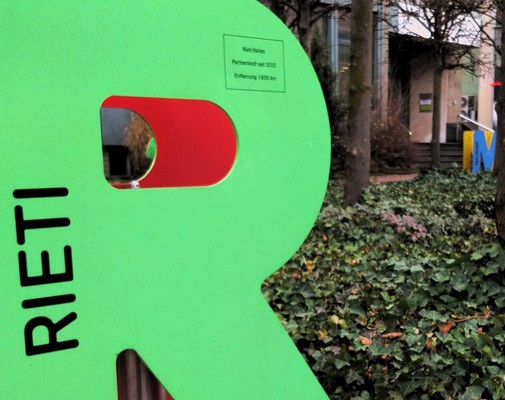
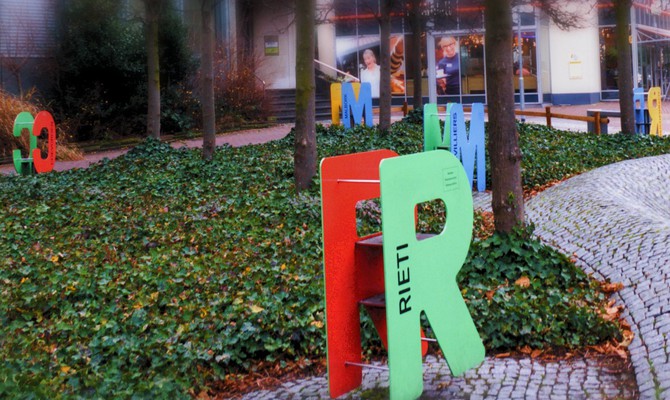
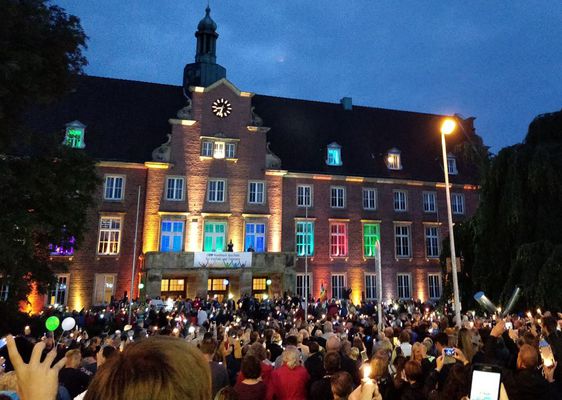
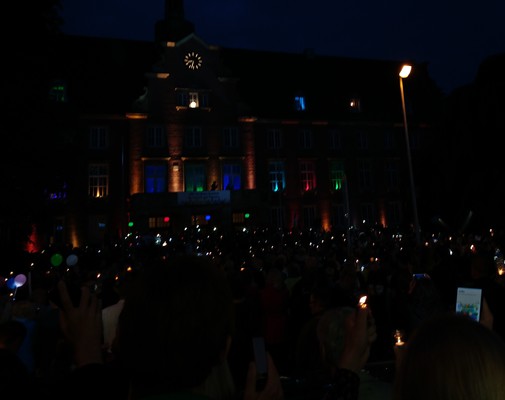
Migration and integration were always a part of Nordhorn´s history.
Migration arises when a person changes the location of their usual place of residence. International migration occurs when this movement crosses national boundaries. In former times Nordhorn was known for its textile industry. The factories RAWE, NINO and Povel have marked the townscape and have drawn multiple immigrants from several European countries. Those cititzens became part of Nordhorn’s society.
Even when the factories fell into insolvency many migrants stayed in their new home. Nowadays a noteworthy percentage of inhabitants features a multicultural background. In order to integrate those living here and maintain in peace Nordhorn signed its first contract in 1963 with Montivilliers (France) and Coevorden (Netherlands) to build a connection between cities after World War II. In 1989 Reichenbach (ancient DDR) joined the arrangement, followed by Malbork (Poland) in 1995. Finally Rieti (Italy) completed the settlement in 2010. Unlike former aims, today the actual idea is to support the European idea of paving the way to a more united and international community.
That is the reason why we chose pictures of the “Europaplatz” (European Square) in Nordhorn city centre. You can recognize the initial letters of Nordhorn’s twin cities. Every city is represented by a letter with a height of approximately one meter. In the foreground there is the “R” which embodies Rieti. In the background you can spot some of the other letters.
To us the pictures are a strong symbol for migration/integration since its significance of the European idea. As Nordhorn established the letters in the cityscape, it shows great tolerance and open-mindedness to foreign countries and therefore to its citizens. Furthermore, younger generations are encouraged to become familiar with other countries and to discover different cultures. Thereby Nordhorn facilitates an enhanced integration. This will, in the long term, lead to a more connected and tolerant society.
International friendship is an element of migration. To support and protect it shall be the duty of all state authorities.
While more and more refugees arrived throughout Germany and Nordhorn in 2014, there were on one hand a lot of people who supported them and got involved in refugee aid. On the other hand a group of people, led by intolerance and racism, arose. In form of riots they terrorised people particularly in the East of Germany.
This group got plentiful of attention from the media and seemed to obfuscate the common opinion. In order to stand up for human rights as well as justice and a tolerant, open-minded society, citizens met for the peaceful demonstration “Nordhorn leuchtet – Wir sind mehr” (Nordhorn shines – We are more). It took place in many other cities such as Hannover and Erfurt as well.
The pictures show the demonstration in Nordhorn in front of the town hall on 6th September 2018. 1500 people held up lights and remained silent as an outcry of humanity.
The pictures are a symbol of migration and integration in Nordhorn for the reason that it portrays the attitude of Nordhorn’s citizens towards integration. It depicts the people’s commitment against the right-wing movement. Nordhorn wants to ensure diversity and to fight prejudices for all inhabitants. Therefore, migrants can live a peaceful life in Nordhorn without fearing hate.
All in all, the chosen motives exhibit similarities as well as differences. While the first motif formed throughout the past decades and is durable, the second lasted for a short period of time. Prima facie, different conflicts on the pictures are triggered by different reasons; the image of the initial letters was caused by World War II and guest workers moving to Nordhorn whereas the photograph of the demonstration was caused by the recent wave of refugees.
But after going into detail, one can realise that these conflicts are similar and that Nordhorn, in both cases, tried to stand up for migrants and tolerance towards other cultures. This shows that comparable conflicts can appear several times throughout history but that there are different ways to solve them in spite of the fact that the general idea of migration and integration did not adjust.